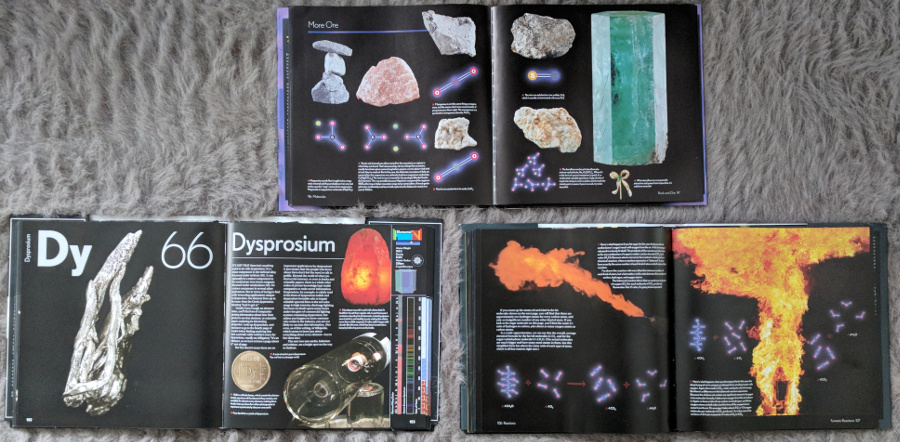The Elements, Molecules, Reactions trilogy
-
home.theodoregray.com/bookproducts/autographed-and-gift-wrapped-trilogy-of-the-elements-molecules-and-reactions
- Popular science trilogy by Theodore Gray
-
elements-trilogy-1518137903374.jpg
The Elements, Molecules and Reactions opened up to a random pageCredit: Theodore Gray and Nick Mann. Fair use.Source: own photographReviews
Please sign in or register to add your own review.
Gorgeous books that make chemistry accessible through powerful visual explanations and humorIn a previous life, Theodore Gray co-founded Wolfram Research and led the design of the user interface for Mathematica, a comprehensive technical computing software package used in many fields. Since leaving Wolfram Research, Gray has focused on conveying his own passion and excitement for science through books, iOS apps and artistic projects like a physical periodic table.
The Elements, Molecules and Reactions is a trilogy of richly illustrated books best enjoyed in their beautiful hardcover editions, written by Gray with photographer Nick Mann and other collaborators.
As you might expect, the first book, The Elements, takes the reader on a journey through the periodic table. I found this book the weakest of the trilogy; the structure forces the author several times to say that element so-and-so is just not very interesting, so why don’t we just move on. That said, the photographs are still gorgeous, and the book contains a good introduction to concepts like the atomic orbitals.
In contrast, Molecules and Reactions are much more substantive, offering powerful explanations for why atoms stick together in certain configurations—or come apart—while introducing just enough jargon to give you the foundation for learning more, if you want to. The explanation for entropy offered in Reactions is, by far, the best I’ve ever come across.

The Elements, Molecules and Reactions opened up to a random page (Credit: Theodore Gray and Nick Mann. Fair use.)A Cabinet of Curiosities
The books rely heavily on Gray’s vast personal collection of objects that represent different elements and molecules, including rare and dangerous ones. Opening up a few random pages, I find photographs of opium boxes, a Kevlar glove, trombone oil, and an antique tin of saccharin.
Rather than lots of text with smaller photos, the images take center stage. In The Elements, each element in the periodic table gets at least one full photo page (you can preview the pages here). In addition to photos, Molecules and Reactions also make frequent use of chemical drawings in a simplified style that is easy to understand.
The text and images are presented in an unusual free-flowing layout that doesn’t always work perfectly if you’re reading in one sitting, but which makes the books a pleasure to pick up and open to a random page, even after you’ve finished them. Gray writes in an informal, casual style, for example (from Molecules):
“Undecane—a straight-chain hydrocarbon with eleven carbons—is, I swear, a moth pheromone. They use it to attract mates, in much the same way the human male uses it in sports carts (it’s one of the higher-numbered hydrocarbons in gasoline).”
The books also use lots of humor and personal anecdotes, but unlike a book like “We Have No Idea”, it’s on the whole more focused on explaining things than delivering puns or jokes. Reading any book in the trilogy feels a bit like visiting a museum (or a cabinet of curiosities) with your personal tour guide who explains everything with a wink and a half-smile.
The Verdict
I personally started with Molecules; if I had begun with The Elements, I’m not sure I would have kept going. It’s not a bad book, it’s just not nearly as gripping as the other two. As it is, I finished all three books within a few weeks (there’s not that much text).
I was neither especially good nor especially bad at chemistry in school, but I never felt that the explanations I got out of it actually helped me understand the “why”. Why do atoms prefer certain configurations over others? Why do chemical reactions release energy? Why can small changes in a chemical formula represent such massive changes in a molecule’s appearance or behavior?
Gray’s books help any reader to at least grapple with these questions in a more informed and intuitive way. They make a great gift for curious teenagers, but I would also recommend them to any lifelong learner. If you can, you’ll want to buy or borrow the whole set, but if you just want to check out one book, I suggest making it Molecules or Reactions.
